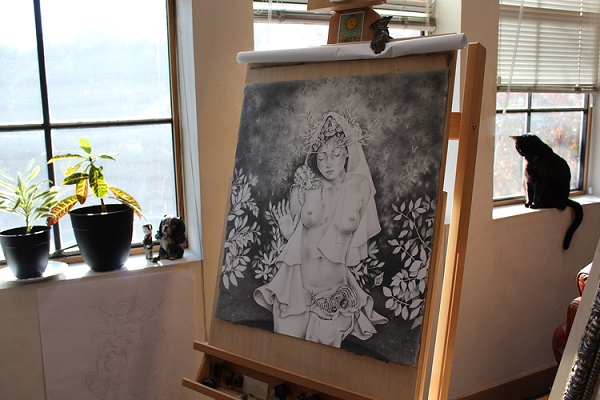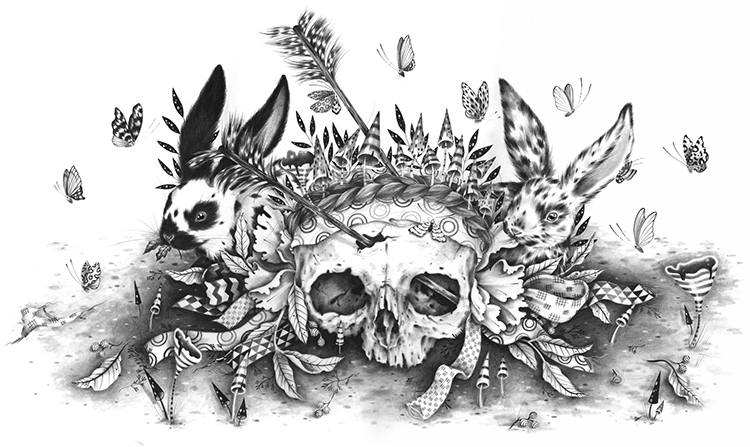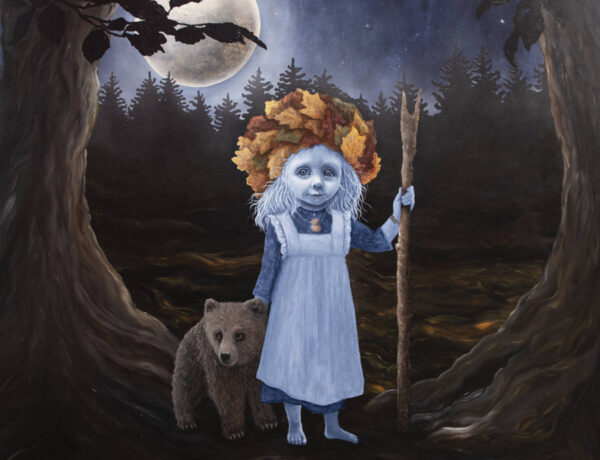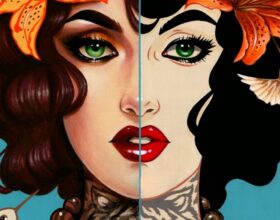The artwork of Nicomi Nix Turner -aka Fernbeds- will remind you to take a walk through the woods. Stop to smell the roses, and thank the pollinators with each bite of food you enjoy. Nicomi’s environmental graphite drawings reconnect you to nature with intricate, and incredibly detailed, animals and female figures on paper. We are, after all, also part of nature. Her black and white pieces tell stories as they explore the life cycle, how Life and Death work harmoniously as one. Turner’s drawings will have you thinking more in depth about religion and spirituality, as well. Her work is tightly packed full of religious symbolism, from all cultures and times throughout history. Turner’s extensive research on these topics comes out eloquently through her pencil.
“My grandfather has been immensely influential in my works. His eccentricities, and the various art and historical pieces he has collected, inspired me at an early age.”∼ Nicomi Nix Turner
Currently based in Oakland, California, Nicomi Nix Turner’s childhood growing up in a woodsy area of Oregon greatly inspires her botanical themed drawings. I was lucky enough to be able to ask Nicomi a few questions about her artwork for beautiful.bizarre Issue 014, and am grateful she took time away from preparing for an upcoming solo exhibit in November 2016 at Paradigm Gallery.
.Nicomi Nix Turner
.
Most of your drawings don’t have backgrounds. I remember, in a drawing class I took once, the drawing instructor always piping in at students “what are you going to do with the background?”, “don’t forget about your background!”, “you can’t leave your background blank”, and the like. I get excited when I see one of your drawings partly because of that; I cheer in my head “yes, there’s no background and it WORKS. Take that!”. But really, the blank white backgrounds compliment the intricacy of your work. It creates a nice balance. There are a few pieces you do go in and add a background. How do you choose when to have a background and when you don’t? Rumor has it, you’re anti-eraser, and all stray lines are there to stay and are gracefully incorporated into the final drawing. Does that influence you in the decision?
I think the background sometimes really isn’t necessary. I’m big on the emotional story happening with the protagonist of the piece, and filling in endless symbolism hidden about their person or bound to them. Sometimes I look at backgrounds as a meaningless gesture. Just kind of thrown in there for the sake of filling voids. I like those voids.
I find there is something whole in embracing the nothingness and blankness. When you leave out the background, something interesting happens- you are focused on what’s in front of you and you allow yourself to get lost in that moment. I’ve started experimenting with slightly ethereal backgrounds in a few pieces and I like it, but I don’t like to force an environment where I don’t feel like one should be. Conversely, a lot the pieces I’m starting in on now for my solo show at Paradigm Gallery in November, will be a mix of the two: stark barren isolation and dense coverings enveloping the subject.
Ah, the eraser question… I don’t erase “mistakes”. I like to think that if I drop my pencil, misplace a line or mess up somehow, that it is part of the whole piece. Most of the time, I just try to work slowly so that stray lines or bumps don’t happen as often.
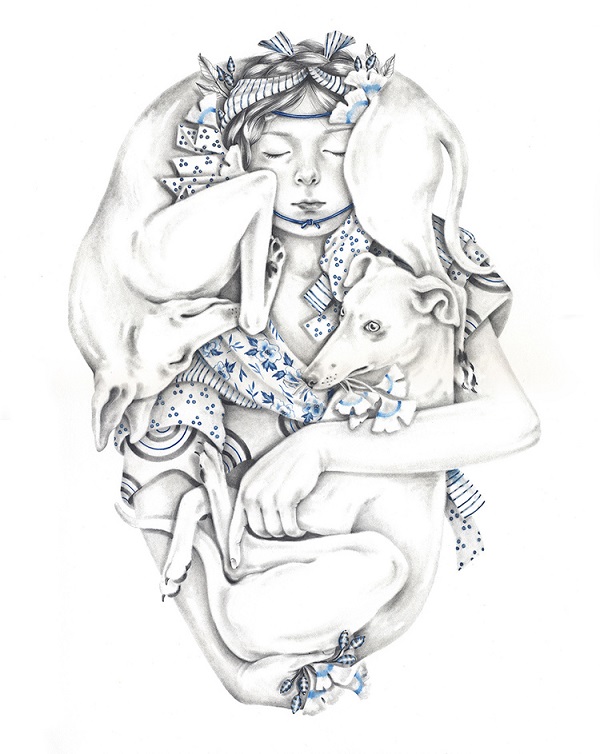
Let’s say that there is a time where you sit down to create, but nothing comes to you. You put your pencil to paper but your brain and hands aren’t communicating. Flipping through your sketchbook of great potential graphite masterpieces isn’t igniting your spark. You just have no inspiration. Where do you go, or what do you do, to recharge your creative energy?
Often if I’m searching for a little…well, I wouldn’t say inspiration but perhaps motivation…I’ll go on long walks, visit museums and surround myself with the works of masters, flip through my old sketches and notes, start a new book… I find that because I draw every day for hours on end, I need to [do] little things to keep pushing myself. One of the best things for this, I have found, is traveling to other countries. Every time I have been fortunate enough to go abroad, I come back home with such a desire to create and so many ideas in my head that there’s nothing more I can do but sit and work out all of these new ideas. I write a lot…nothing tangible or interesting but odd things that pop into my head and those usually inspire something down the road. I keep notebooks full of these jottings but mainly they are on scraps of paper and they just litter my sketchbooks, floor, easels…but they are such good triggers for thoughts that lead to something bigger.
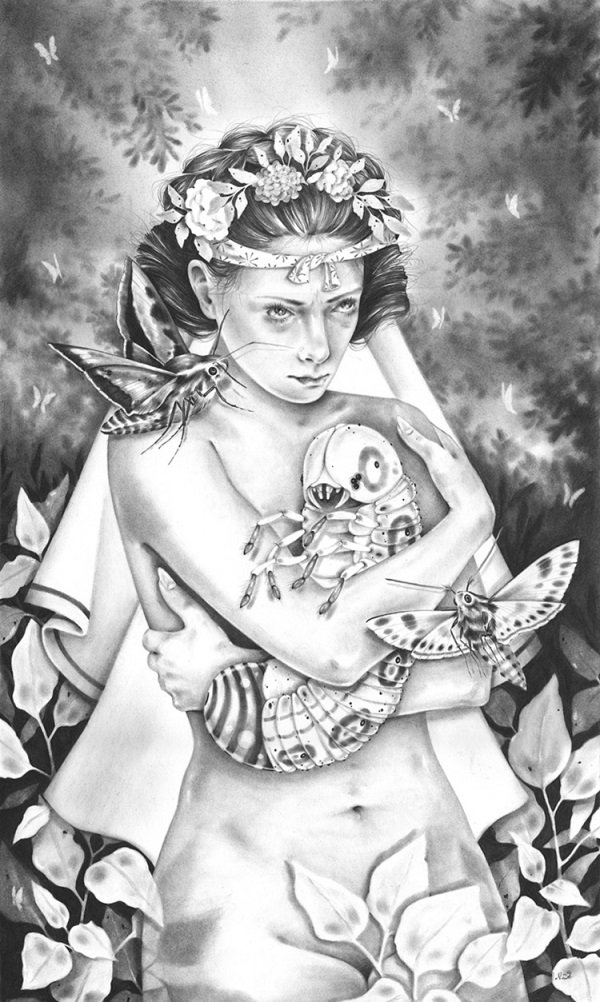
Your cat, Luna, is your studio companion. I may, or may not have accidentally mixed up the “Help Coming Up With Awesome Interview Questions” spell with the “Body Switching” spell. Oops. Anyways, I’m now your cat for a day. What would I be observing as you work in your studio? Graphite is a more difficult medium to work with, yet there are those who mistake your work for ink wash. That’s how expertly you can blend. Give us a run through of the behind-the-scenes and process of A Day as Luna in the Studio with Nicomi.
Before I moved my studio into a larger space, my cat Luna was indeed a true creation companion… well, she tried to be…
If I could guess right, I would think that Luna would consider my day-to-day as rather boring. I start my mornings off by figuring out where to begin. Lately I have multiple pieces in progress, for the sake of deadlines, so diving in is fairly easy. I follow the same process for each piece I work on: thumbnail compositions, preliminary drawings, final layout, seemingly endless layering and toning of graphite, refining and detailing. At any given day in the studio, I am usually perched with my face about 3 inches from my paper.
Hearing people ask if the works are ink washes is really gratifying since I spend a lot of time trying to work the medium into smooth layers. With each piece taking a good deal of time to complete, I have taught myself different techniques, which make the work easier on my hands and eyes without sacrificing the detail.
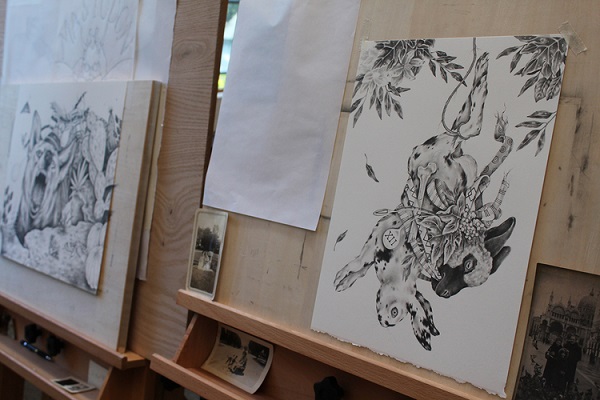
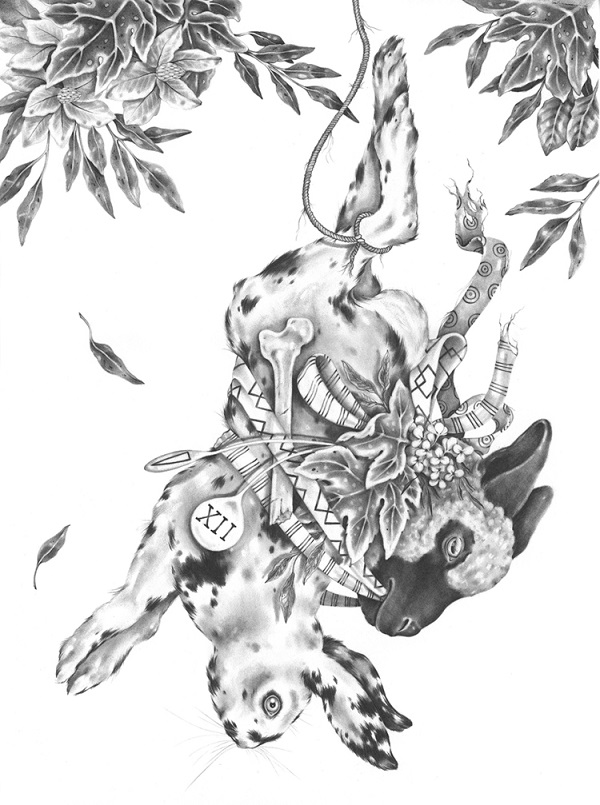
The binding aspects of your pieces have especially piqued my interest. Often times, the women and animals you bring to life are bound, with various objects, symbols, and plant matter tied to them. You mentioned in post not too long ago that in your past you lost everything in a fire, and attribute that to the tied up figures in your work. Would you care to explain that more in depth?
During a recent train ride from Amsterdam to France, I was sketching. I wasn’t really thinking of what I was sketching, but for the first time, I looked down and asked myself what it meant. I’ve never had a lot of ‘things’. I never really cared or thought too much about my possessions until a fire burned up a lot of those things. I suppose I’ve grown obsessed with this idea of carrying belongings… all belongings, on one’s person. I didn’t realize it until just now that I’ve been doing this in my works since the fire years ago.
Sometimes I feel like these things, objects, matter, bound to the protagonists are almost armor, if you will. Often times, the figure is weighed down motionless under the piles of things they have tied to them.
I’m still not materialistic nor do I have loads of things, but when I am away from home for extended periods of time, I often find myself fretting over a small group of objects that I left behind. I suppose, in a way, I have already tied things to myself.
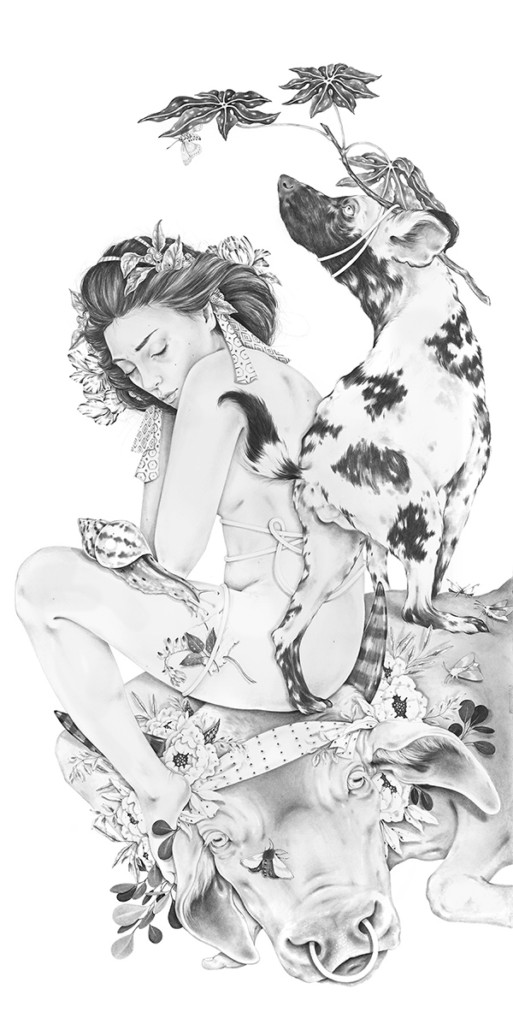

Sometimes, your female characters are looking upward. These pieces are very strong emotionally…for me, I feel their angst, staring up into the sky as if hoping to get a glimpse of something to confirm a belief in God, while at the same time knowing that they may never be able to believe that existence. I could go as far as to say that in these works, you’re also working out the loss of two significant female role models in your life. If you’re comfortable, could you explain these possible connections to your work, and how you feel about them, further?
Of the themes I delve into, the questioning and understanding of belief is something that appears frequently in several pieces. Whether gazing upwards or staring out crying, I try to bring my protagonists to different moments of trying to find God…communing with something that may not be there and the feeling of helpless silence. I sat by both my mother’s and my grandmother’s deathbeds, and watched their faces go from calm to scared…It’s that moment, that feeling, that questioning gaze to the ceiling, I feel I am recalling with these expressions.
I think the loss I have experienced has had a huge effect on my perception of belief. On many occasions, I work out a few of these existentialist monologues with my protagonists… There is certainly a great deal of loneliness reflected.
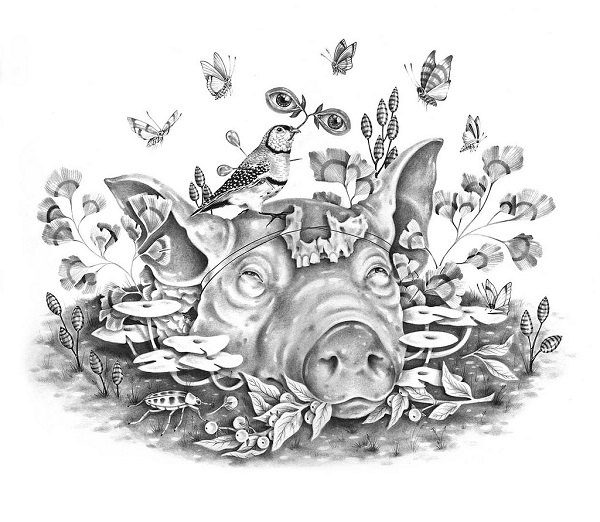
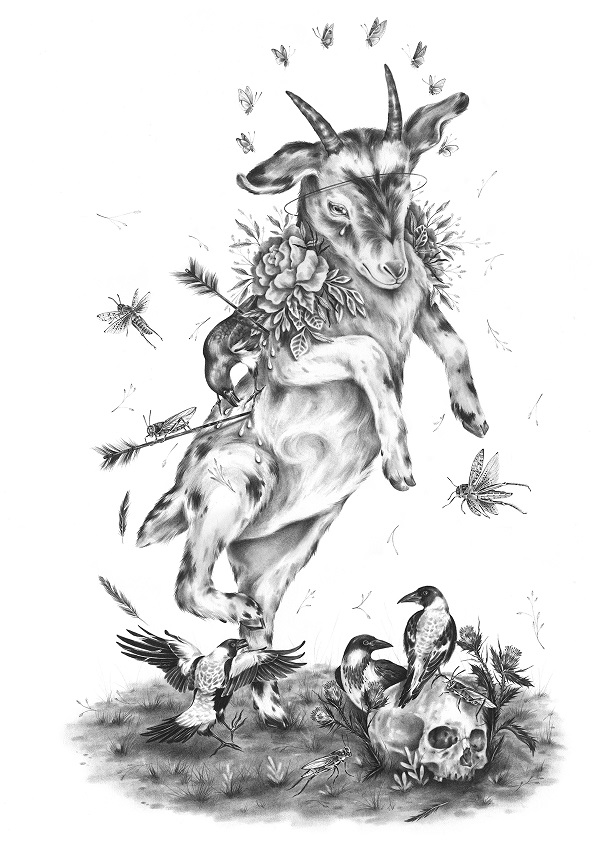
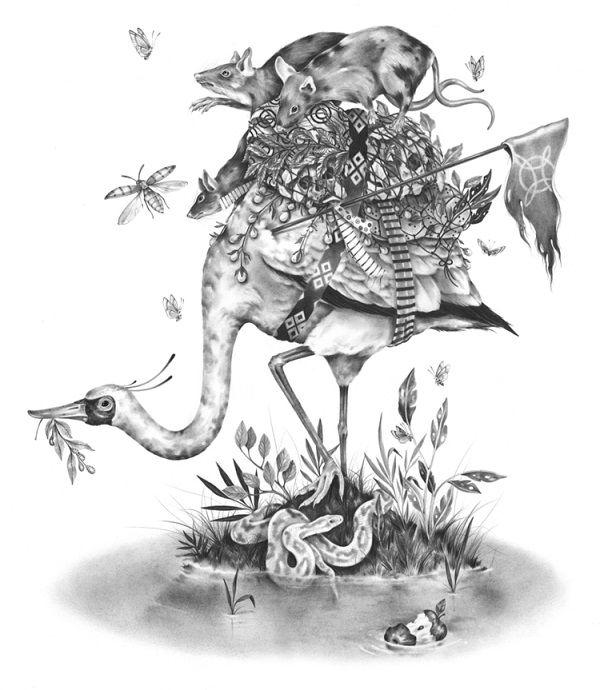
Back to the subject of symbolism; I’ll have to admit that I have very limited knowledge on the topic of religion. It is my understanding that religion is one of many subjects you like to research. Though you seem to like to keep the symbolism in your drawings a little more mysterious, you have explained that the tattooed line we can see on some faces represents overcoming difficult life obstacles, and the strength gained from doing so. You call these lines the “Celestial Equator”. Another symbol you use frequently and catches my attention most is the drawing of an eye. In my experience, I know this as the “All Seeing Eye” from Hinduism, and the Eye of Horus from Ancient Egyptian religion. Would you be so kind as to uncover your meaning for this symbol?
I use the symbolism and hidden imagery in my works not necessarily to tell a broader story, but as more of an esoteric device. Perhaps the reason I do not delve too deep into the meanings of certain symbolic devices in these pieces, is that I don’t want to give it all away, [or] take away the enjoyment that comes from deciding the meaning for yourself, as the viewer. I figure myself as a bit of a Religious hobbyist, studying the dots that connect or divide old and new religions, while trying to gain understanding of the shared allegory. While I am by no means religious, I do value ritual and spiritualism as deep-rooted essences of being human.
Often, certain symbolism carries over to multiple pieces: God’s eye, Moth Halos, Arrows, Teeth…
Moth halos are something I have added to many works as a representation of life’s ebbing fragility- a circle that can be easily broken. I get asked a lot why the women in my piece have a line tattooed over their face. The short answer is that it is their “Celestial Equator”- the projection of their ‘center’ out into space.
Apart from symbolism, I try to relay movement and deeper parts of a story with textiles and texture. As a girl, I was heavily inspired by my Grandparent’s love of the Japanese culture, and the pattern-work executed in the woodblock prints [my Grandfather] collected. This affinity for pattern work has been something of a bridge to me between natural patterns and manmade patterns (hexes, sigils, needlework…etc), and the equal or diverged significances.
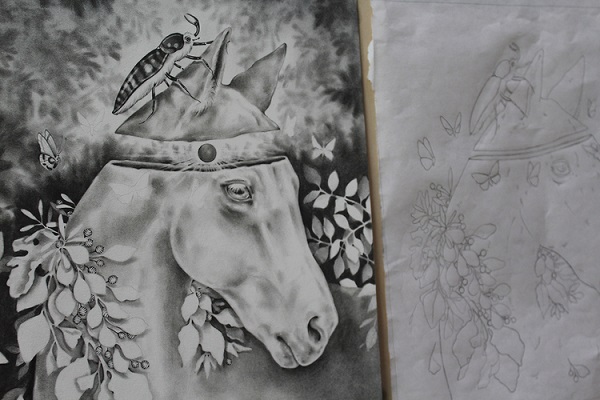
You posted recently about working on a new body of work that involves lots of spiders. What more can you reveal about that, and what other projects do you have lined up that you’d like to share?
Since earlier this year, I have played around in my head the story of brothers: a boy and a spider. The pieces shown in August at Jonathan Levine Gallery, tell the story of the brothers downfall at the hand of an unseen enemy. It’s a small grouping of work and the story is short, but the feeling of bonds, and a looming idea of betrayal, was something I was trying to elude to in the pieces. I always have to laugh at how some viewers react to seeing spiders in my works, often with repulsion, but for years I’ve incorporated insects and “creepy crawlies” into my works out of reverence for them. [I am also working on work for my Paradigm Gallery solo show].
